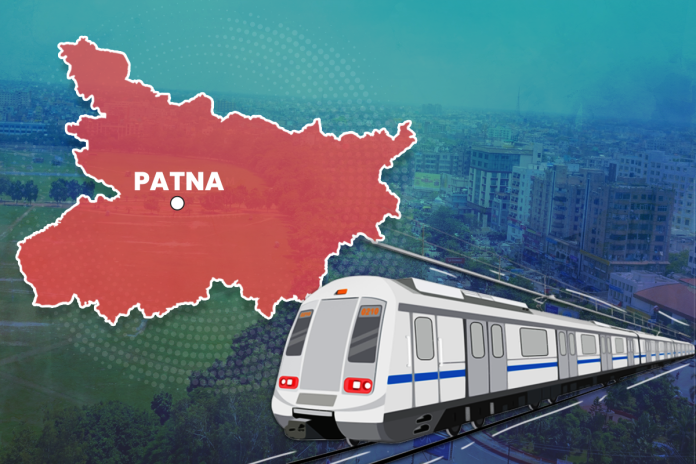Amidst Bihar’s struggles with the challenges of lower urbanisation and inadequate infrastructure development, both of which are prominent indicators of economic development for a region, the development of the Patna Metro project has emerged as a beacon of progress for the state.
Patna is the capital of Bihar State. With an estimated population of 1.68 million in 2011, Patna is the nineteenth most populous city in India with over 2.5 million people by 2022.
In contrast to many rapidly developing cities in India’s growth story, Patna still suffers from major developmental problems added with unemployment, poor public health and poor civic and educational standards for a large section of the population.
In 2015, the National Sample Survey Organisation (NSSO) revealed that, for females, Patna had highest unemployment rate of 34.6 per cent and for males it was the second highest with a rate of 8 per cent.
However, in the pursuit of elevating Bihar’s capital city to the scale of economic development as being witnessed in other cities across the country, the ongoing Patna Metro project emerges as a frontrunner of change.
This project not only promises to redefine the transit patterns but also transform the economic dynamics of the city. Moreover, it holds the potential to attract substantial investments and generate employment opportunities that are pivotal to bringing progress to the capital city.
Bihar’s First Metro Project
The foundation stone for the Metro Rail project was laid in February 2019, representing the beginning of the first-ever mass rapid transit system for the state.
As per the detailed project report (DPR) submitted by RITES, the first phase of Patna Metro spans a total distance of 31.5 km, having two corridors — with its reach to the East-West and North-South orientation of the city.
The East-West corridor-1 connects Danapur in the west to Khemnichak via Bailey Road. The North-South corridor-2 links Karmalichak in southeast Patna, where the new inter-state bus terminal (ISBT) would come up, with Patna Junction via Rajendra Nagar terminal, Ashok Rajpath and Gandhi Maidan.
The Delhi Metro Rail Corporation (DMRC) is responsible for overseeing the development of these metro projects.
Corridor-1, spanning a length of 17.78 km between Danapur and Khemni Chak — is proposed to have over 7 km of elevated section and 10.17 km of underground section.
There will be 14 metro stations, with six underground and eight elevated as the corridor runs to connect major roads like Suguna-Danapur main road, Bailey Road, Fraser Road, Patna Junction station, Mithapur bus stand road, and Patna-Sitamarhi Road.
Further, Corridor-2 extends over 14.5 km, featuring a 6.6 km elevated priority segment and a 7.9 km underground stretch.
Of this, the elevated priority section will have five stations — Malahi Pakri, Khemnichak, Bhoothnath, Zero Mile, and Bus Terminal (New ISBT).
The 7.9 km long underground section will run between Fraser Road to Rajendra Nagar station, consisting of seven underground stations.
As per the plan, the elevated priority corridor is set to be operational by 2025, while the underground section of Corridor-2 is expected to be finished in 2026.
Patna Junction and Khemnichak stations will serve as interchange hubs connecting the two corridors.
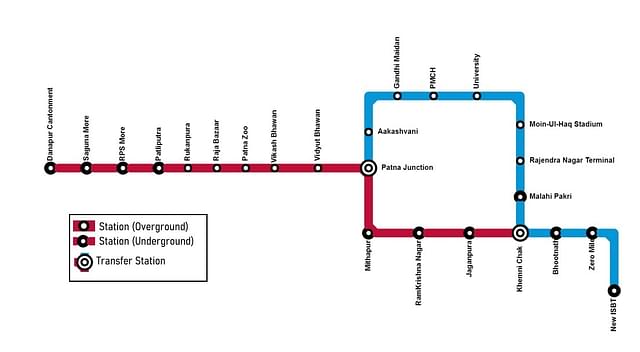
Metro To Link The City, Extending In Both East-West And North-South Directions
As one of the most ambitious projects, it represents a significant leap for the state towards advanced urban infrastructure. The proposed corridors seek to link crucial regions, extending in both east-west and north-south directions across the city.
Professor Abhishek Kumar, an architect and urban planner at NIT Patna, notes the city’s incremental expansion, which extended from the Ganga’s proximity to its distant reaches.
He points out that an important aspect of the city’s transit — the old bus stand has shifted from MithaPul to Bariya, now known as the new ISBT.
Originally situated near Patna Junction, the location of the old Bus Stand formed an informal integration between different modes. However, due to traffic congestion, the bus stand was relocated to the new bypass road.
He says, “Now the metro network will act as a proper integration covering the distance between the new bus stand — ISBT, and also, Zero Mile, with the city’s railway stations.”
Further, the southern side of Patna has seen continuous development, as the city grew over the years. The area, once marked as the city’s limits by the old bypass, is now an integral part of Patna.
The locality, often referred to as the “doctor colony,” is replete with medical professionals and clinics. The planned development in this region allowed for broader roads which helped the elevated metro section to pass through.
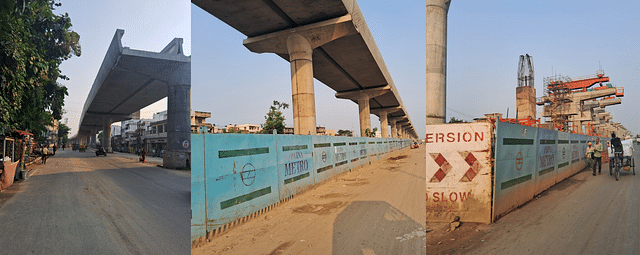
In line with this landscape of the city, the alignment of the metro routes will aid in covering all of the essential areas, starting with the elevated priority section.
Simultaneously, towards the Ganga River, the metro line crosses the major academic stretch along Ashok Rajput Road, where prominent institutions like PMCH, NIT, and Patna University are situated. These areas witness substantial foot traffic daily.
Professor Abhishek adds, “The Ashoka Rajput Road, a major thoroughfare for the city, is presently undergoing significant construction work, including the development of an underground metro and a double-decker flyover for smoother vehicular movements, as currently, this place sees continuous standstill jams due to the high usage of this road.”
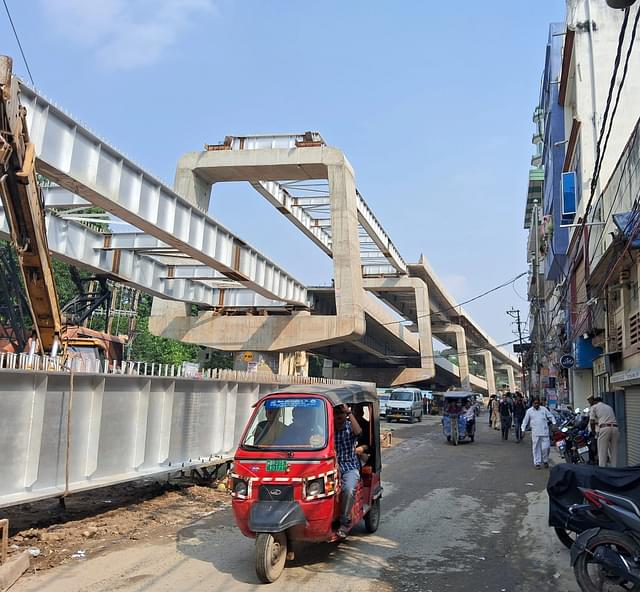
From an administrative perspective, the metro network in the capital city connects to regions such as Bailey Road, Income Tax Chuaraha, and the Bihar Museum, where numerous government and administrative buildings are located.
Further, while explaining the relevance of the metro’s expanse, Abhishek believes that the network, once fully operational is going to bring several benefits to the city. As currently, the bus system is not successful in the city, and cannot be scaled due to the limited road width in the city.
Most of the city’s public transportation heavily depends on shared autos and e-rickshaws, and the introduction of the metro network promises to establish a more advanced and regulated transit system for the residents.
Current Transit Patterns In Patna
At present, the city’s transportation is being dominated by the large numbers of e-rickshaws and auto-rickshaws, that can be spotted at every corner around the entire city.
To a significant extent, it appears as though the entire transport ecosystem is reliant on these modes of shared mobility, even for longer distances. The demand and dominance are such that these services have encroached upon many of city’s bus stops.
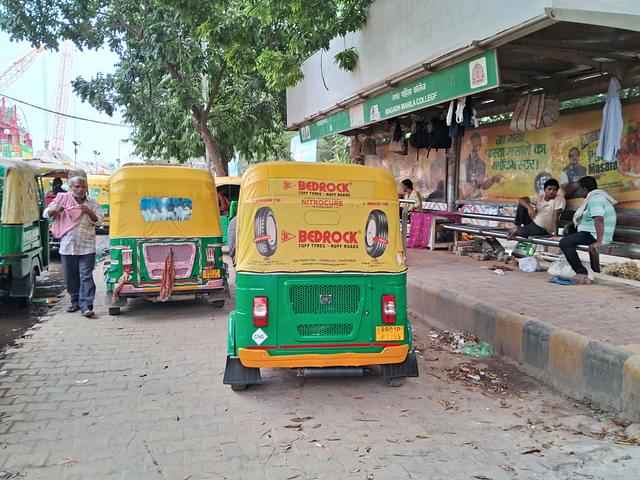
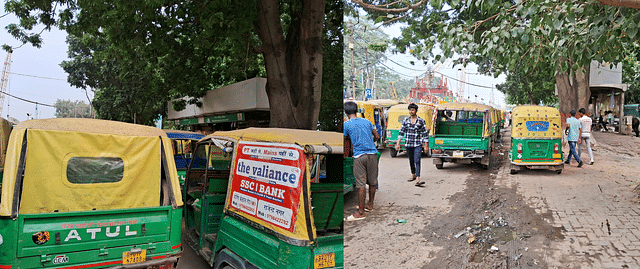
On questioning the huge number of e-rickshaws on city road, with no regulations in its parking, usage, and tariffs, most people had one answer — this is primarily due to Bihar’s high unemployment rates, drawing people to the state’s capital, where many choose e-rickshaw driving as a source of income.
The current situation highlights the lack of regulated public transportation. Buses are scarce and mainly serve the city’s outskirts, many of which were introduced in the city under initiatives like AMRUT and the Smart City Mission.
Anupam Sunil, a Smart City Patna official, sees the introduction of the metro to definitely ease the challenges caused by the autos and rickshaws currently clogging the city’s main roads.
He says, “In particular, the metro’s focus on east-west connectivity is critical, as it links emerging areas like Danapur to the city’s core and the alignment considers future growth over the next 20-30 years.”
He expects that the metro will serve as the longer mass transit, and the rickshaws, which are in huge numbers, should be required to connect the end-to-end areas, essentially pointing towards planning a modal spilt for transportation.
He emphasises the importance of feeder services, well-timed stops, and coordination between autos, rickshaws, and limited buses to support the metro effectively.
“The city’s development plans aim to align with the trend of advancing with the metro system. However, the prevalence of informality and irregularities still persists with the reliance on traditional transit systems. This approach may present challenges when the metro begins operations, as it must be complemented by supporting infrastructure,” he said.
Further, what it currently lacks are connectivity to the older city with denser areas, which is expected to be covered later.

Mood Around The Metro And Its Current Execution Challenges
At present, the prevailing view is that the metro is not intended to lure car users but rather to target daily commuters using shared autos and e-rickshaws, given the higher prevalence of these shared vehicles compared to private cars.
The metro will be crucial for people spending 30-40 minutes daily, hopping between shared autos during longer city commutes, addressing the need for convenient, extended public transit.
There is a shared sense of excitement among commuters, auto and e-rickshaw drivers about the upcoming metro infrastructure — most of which largely stems from anticipation of something new in their city.
Recognising the city and state’s relative lack of development compared to other regions, several students and workers believe that the metro will bring them greater benefits, enhancing future development and quality of life.
Auto drivers see the metro as a solution to road congestion while being confident that it will not eliminate their daily work. They believe that the metro, while covering longer distances, will not reach all areas, narrow streets, leaving room for last-mile connectivity opportunities.
Sandeep, a young auto driver migrated from north of the Ganga River in search of economic opportunities in the city. Unlike most drivers who focus on shared rides, Sandeep chooses to work only through cab aggregators like Ola/Uber.
He wants the metro to take over long-distance travel, reducing the need for shared rickshaws on such distances, and rather increase regulated aggregator use which gives greater convenience to them and also to the passengers.
In terms of implementation, the public acknowledges ongoing progress as they witness construction throughout the city. However, they continue to grapple with challenges, including severe congestion, gridlocks due to mismanaged traffic, and limited lanes for both vehicles and pedestrians.
Taking the case of the core area of Gandhi Maidan, the current construction work has disrupted the region, much like other parts of the city.
At the current state, most of such areas in the city lie inaccessible through vehicles. It is nearly impossible to reach any destination in Patna from end to end using private vehicles or cabs, as the metro construction has caused roadblocks and construction-related issues, causing drivers to refuse to go further.
There is limited space for both vehicular and pedestrian movement in these areas, while autos and rickshaws occupy most of the roads, added with space for drainage and gutters.
Expectations Once Metro Is Operational
During Swarajya’s interactions with the public, many people in the city were found to be unfamiliar with the features of the metro — as for them, it will be their first exposure to understanding elevated corridors and underground transportation.
In line with such situations, experts are also conducting several studies —to assess people’s willingness to travel and pay for metro usage, also raising awareness among citizens.
For residents who have experienced metro systems in other cities, like Shweta Lal, who is pursuing her PhD in Delhi but grew up in Patna, the potential of the metro holds a promise of greater transformations in the city when as it becomes operational.
She says, that currently, not many people are aware of the metro, but once it is operational, city populations, especially students and youngsters will reap the greatest benefits, who for years have been relying on irregular modes to reach destinations within the city.
It will be essential in facilitating upward mobility for individuals, while also introducing growth opportunities in commerce, real estate investments and employment, which will be stimulated by the presence of the metro in the respective regions.


